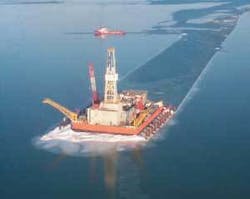Supply, demand, price
Predicting oil and gas supply and demand is always a dicey matter.
Forecasts by the US Energy Information Administration (EIA) and International Energy Agency (IEA) peg the future demand for oil, assuming current trends continue, at 100-115 million b/d in 20-25 years, compared with about 83 million b/d today. Natural gas demand is expected to grow even faster, climbing to 156 tcf/year in 2025 from 92 tcf in 2002, according to EIA.
Whether the supply of oil and gas will be available to meet that projected demand remains an open question.
A growing chorus of experts contend that a peak in global oil production is imminent, followed by a precipitous decline. Some attach that forecast to natural gas as well, albeit placing the peak further off. Opponents of that view see a peak in hydrocarbon production as probably decades away, followed by a plateau that conveniently carries us to a world fueled by nonfossil fuel alternatives.
The peak-oil debate continues to rage on, but there is consensus on two notions: 1) the world’s conventional oil supply will be concentrated increasingly in nations belonging to the Organization of Petroleum Exporting Countries, especially those in the troubled Persian Gulf region; and 2) most of the “low-hanging fruit” outside of OPEC, in terms of oil, has been harvested.
To some extent, these scenarios are playing out now-hence the recent spike in oil prices being sustained over more than 2 years as the world’s cushion of spare capacity dwindled to a sliver.
As a result, to a degree not seen since the late 1970s and early 1980s, there is a new urgency to find more oil and gas.
While the world’s oil- and gas-bearing structures have so far yielded about 1.5 trillion barrels of oil equivalent (BOE) of the 20 trillion BOE of hydrocarbons thought to remain in situ, the challenge of finding and accessing those undiscovered reserves becomes ever greater.
In a recent report, the IEA discussed the challenge of providing the 1.5 trillion BOE of oil and natural gas equivalent that economists predict the world will need over the next 25 years. Meeting that challenge will require an investment of about $17 trillion during that period, according to IEA.
Capital availability for funding this quarter-century of oil and gas investment is now deemed less of a concern these days, thanks to consensus forecasts that suggest persistently higher prices than projections of just a few years ago. No better indicator of the exploded price expectations is the Annual Energy Outlook (AEO) published by EIA. In its 2005 AEO, the statistical arm of the US Department of Energy predicted a world oil price inching up to $25/bbl by 2010 and a little more than $30 in 2025 (both projections in 2003 dollars). In its 2006 AEO, EIA projected a 2025 world oil price, in today’s dollars, of $54/bbl. Similarly, IEA sees world oil prices at $52/bbl in a scenario that envisions deferred investment in added oil production capacity in the Middle East and North African nations.
Gas price projections are a little less heated but still hover around $4-6/MMBTU at the wellhead in the US, the kind of price that could still sustain a lot of drilling and a healthy LNG trade.
Such continuing high prices for commodities tend to spawn a ready supply of cash to fund tomorrow’s oil and gas exploration and development investments.
But even a cash-flush industry is already grappling with wrenching changes that will have a greater bearing on the future search for hydrocarbons than how to fund it.
Both operating and service companies must cope with barriers of geography, access, political risks, personnel constraints, and a changing business culture.
Rise of NOCs
The skyrocketing oil prices of the past few years have helped embolden oil-rich nations to seek ever-greater rents from the exploitation of their resources. Fiscal terms in major oil exporters such as Venezuela and Russia are being scrapped in lieu of terms much more favorable to the host governments. There are clear signs of renationalization of oil and gas assets, notably in Latin America.
National oil companies (NOCs) in particular are reasserting themselves. They not only are staking out greater claims on domestic resources but also venturing abroad increasingly to compete with international oil companies (IOCs) in prospective areas.
That sets the stage for growing competition between NOCs and IOCs for even smaller pieces of the same pie. In decades past, NOCs were largely political entities, extensions of host governments that mostly handled licensing and resource rent collections. But today many NOCs have the technological sophistication to handle most of the exploration and production responsibilities that in the past were the exclusive province of the IOCs. Armed with that knowledge and experience, NOCs are beginning to gain entry into other producing or prospective countries alongside the IOCs, points out Mike Bahorich, Apache Corp. executive vice-president for exploration and production technology.
“With the NOCs moving into these areas, there’s even more competition in a smaller sandbox,” Bahorich says. “It will be a highly competitive environment for IOCs.”
A great portion of the world’s most prospective basins for exploration remains off-limits, either to foreign investment or to any access at all. Just as once-bright opportunities are now being foreclosed to outside investment in countries such as Russia and Venezuela, the Middle East-home to the bulk of the world’s proven reserves-remains mostly shut to foreign participation owing to national policies or geopolitics.
Some analysts have pointed out that the roles of IOCs and NOCs are changing as host governments become increasingly reluctant to cede large equity positions in acreage and consequent production in an era of high prices. They speculate that some IOCs will even act essentially as “E&P service companies” to NOCs.
Access limits of a different nature afflict the US, where much of the nation’s most prospective acreage remains off-limits to drilling over environmental concerns. For example, the National Petroleum Council estimates that 125 tcf of natural gas is either off-limits or significantly constrained because of extra costs and delays resulting from federal lands restrictions in the Rocky Mountains. This equals 53% of the undiscovered recoverable natural gas resource in the region. In addition, much of Alaska’s North Slope-which could hold 100 billion bbl of original oil in place-is off-limits to drilling. And outside of the central and western Gulf of Mexico and parts of Offshore Alaska, drilling moratoriums cover the nation’s Outer Continental Shelf.
Diminished exploration success
As a result of the lack of access, personnel strains, and Wall Street pressures for quick, safe returns, exploration opportunities have dwindled, with a consequent decline in discovery rates. According to Englewood, Colo.-based IHS Energy, new field discoveries of petroleum liquids in 2004 reached their lowest point since World War II.
Discoveries of giant- and elephant-sized fields have fallen as well, resulting in a shrinking average discovery size. The average discovery size of the past 25 years is less than a tenth of that seen during 1925-55, according to IHS. The consultant also notes that only 11 discoveries during 2000-05 exceeded 1 billion BOE-most of them in the Middle East.
Consultant Wood Mackenzie, Edinburgh, cites a general downward trend of reserves replacement by the 28 leading IOCs. During 1995-2004, these companies logged reserves replacement ratios that slipped to well under 100% toward the end of the period vs. over 100% at the outset.
And what reserves are being replaced increasingly are being found in and near existing discoveries. More reserves were found in place in existing discoveries than were discovered during 1995-2004, according to IHS.
As a result, estimates of the world’s proven reserves have held steady or increased slightly in recent years. That can be attributed to industry’s improved ability to increase recovery rates and to better delineate what’s been found. But there are limits.
Bahorich notes the growing disparity between OPEC and non-OPEC oil supply. Of global proved oil reserves totaling about 1.2 trillion bbl, non-OPEC nations outside the former Soviet Union account for less than 200 billion bbl. At the same time, those non-OPEC nations account for about 48 million b/d of the total world oil supply of about 83 million b/d.
“Consider the world’s reserves today of 1.2 trillion bbl,” he says. “About 15% of the world’s reserves is producing nearly half of the world’s production. We’re working that non-OPEC acreage incredibly hard. It is stunning to consider what level of production could be achieved if all of the world’s acreage were worked this hard.”
According to Bahorich, “Acreage available to IOCs is limited and is being aggressively developed, which has resulted in a much lower reserves-to-production ratio than in OPEC-dominated areas. Production from this limited acreage may peak in the next 20 years, and competition will become increasingly fierce.”
With an urgency to replace reserves, that suggests operators must balance expanded exploration efforts with a continued emphasis on new technology to better delineate reservoirs and to improve recovery rates in existing fields, all while keeping costs down.
“As service costs continue to rise,” Bahorich noted, “exploration opportunities must compete for rigs with lower-risk development wells.”
Apache’s own focused strategy points to that kind of balance.
“In some areas, we operate like a manufacturer,” Bahorich says. “For example, in Canada, we might drill 1,000 wells in a year, shaving a few dollars off the operation of each well.”
At the same time, operators need a balanced approach between exploration and reservoir optimization, says Thierry Pilenko, CEO and chairman of Veritas DGC Inc., Houston.
“Ultimately, to meet growing worldwide demand, we must increase investments in exploration simply because exploration has been neglected for so long,” he says. “While I would not want to underestimate the remarkable efforts that were made to increase ultimate recovery from existing fields, a 20-year flat line in spending-not including inflation-on exploration technologies and techniques has been a major contributor to the current fundamentals of low spare capacity. I expect it also influenced the current shortage of truly viable prospects.”
Exploration opportunities
While it focuses on select areas, Apache remains one of the world’s leading exploration companies.
“We believe in choosing very few areas and being the leader in those areas,” Bahorich says. He cites Apache’s roles as the top acreage holder on the Gulf of Mexico shelf, most aggressive exploration operator in Australia, top producer in Egypt’s Western Desert, and a leading operator in Canada, the UK North Sea, and the onshore US.
Noting that those regions also offer low political risk and low geologic risk, Bahorich says that it is important for his company to “lead in areas that fit our strengths. That’s what has helped us provide a consistent return for shareholders over the long term.”
Despite the common perception that there are few giants and fewer elephants still to be found, Pilenko contends there remains “tremendous opportunity” for new and significant discoveries around the world.
“One would immediately think about the frontier areas such as the Arctic, Siberia, the Barents Sea, or Kazakhstan,” he says. “However, we believe there is still a great potential in traditional areas when we look deeper or when we better understand the geology-for example, in the subsalt formations of the deepwater Gulf of Mexico or in West Africa. These are areas of complex salt tectonics, but potentially offer great hydrocarbon systems.”




